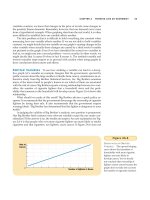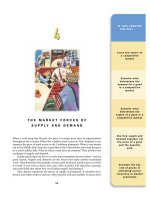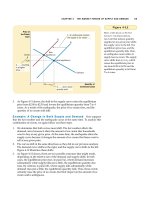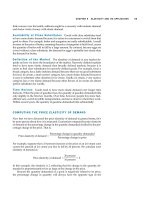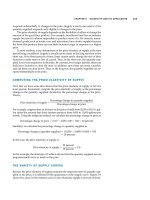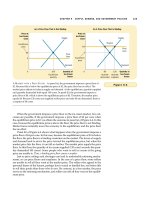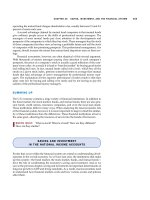Tài liệu Ten Principles of Economics - Part 59 pptx
Bạn đang xem bản rút gọn của tài liệu. Xem và tải ngay bản đầy đủ của tài liệu tại đây (321.15 KB, 10 trang )
CHAPTER 26 UNEMPLOYMENT AND ITS NATURAL RATE 599
equilibrium wage of $2 and hiring Ted. It can offer $10 per hour, inducing both Bill
and Ted to apply for the job. By choosing randomly between these two applicants
and turning the other away, the firm has a fifty-fifty chance of hiring the compe-
tent one. By contrast, if the firm offers any lower wage, it is sure to hire the incom-
petent worker.
In many situations in life, in-
formation is asymmetric: One
person in a transaction knows
more about what is going on
than the other person. This
possibility raises a variety of
interesting problems for eco-
nomic theory. Some of these
problems were highlighted in
our description of the theory of
efficiency wages. These prob-
lems, however, go beyond the
study of unemployment.
The worker-quality variant
of efficiency-wage theory illus-
trates a general principle called adverse selection. Adverse
selection arises when one person knows more about the at-
tributes of a good than another and, as a result, the unin-
formed person runs the risk of being sold a good of low
quality. In the case of worker quality, for instance, workers
have better information about their own abilities than firms
do. When a firm cuts the wage it pays, the selection of work-
ers changes in a way that is adverse to the firm.
Adverse selection arises in many other circumstances.
Here are two examples:
◆ Sellers of used cars know their vehicles’ defects,
whereas buyers often do not. Because owners of the
worst cars are more likely to sell them than are the
owners of the best cars, buyers are correctly apprehen-
sive about getting a “lemon.” As a result, many people
avoid buying cars in the used car market.
◆ Buyers of health insurance know more about their own
health problems than do insurance companies. Be-
cause people with greater hidden health problems are
more likely to buy health insurance than are other peo-
ple, the price of health insurance reflects the costs of a
sicker-than-average person. As a result, people with av-
erage health problems are discouraged by the high
price from buying health insurance.
In each case, the market for the product—used cars or
health insurance—does not work as well as it might be-
cause of the problem of adverse selection.
Similarly, the worker-effort variant of efficiency-wage
theory illustrates a general phenomenon called moral haz-
ard. Moral hazard arises when one person, called the agent,
is performing some task on behalf of another person, called
the principal. Because the principal cannot per fectly monitor
the agent’s behavior, the agent tends to under take less ef-
fort than the principal considers desirable. The term moral
hazard refers to the risk of dishonest or other wise inappro-
priate behavior by the agent. In such a situation, the princi-
pal tries various ways to encourage the agent to act more
responsibly.
In an employment relationship, the firm is the principal
and the worker is the agent. The moral-hazard problem is
the temptation of imper fectly monitored workers to shirk
their responsibilities. According to the worker-effort variant
of efficiency-wage theory, the principal can encourage the
agent not to shirk by paying a wage above the equilibrium
level because then the agent has more to lose if caught
shirking. In this way, high wages reduce the problem of
moral hazard.
Moral hazard arises in many other situations. Here are
some examples:
◆ A homeowner with fire insurance buys too few fire ex-
tinguishers. The reason is that the homeowner bears
the cost of the extinguisher while the insurance com-
pany receives much of the benefit.
◆ A babysitter allows children to watch more television
than the parents of the children prefer. The reason is
that more educational activities require more energy
from the babysitter, even though they are beneficial for
the children.
◆ A family lives near a river with a high risk of flooding.
The reason it continues to live there is that the family
enjoys the scenic views, and the government will bear
part of the cost when it provides disaster relief after
a flood.
Can you identify the principal and the agent in each of these
three situations? How do you think the principal in each
case might solve the problem of moral hazard?
FYI
The Economics
of Asymmetric
Information
600 PART NINE THE REAL ECONOMY IN THE LONG RUN
CASE STUDY
HENRY FORD AND THE VERY GENEROUS
$5-A-DAY WAGE
Henry Ford was an industrial visionary. As founder of the Ford Motor Com-
pany, he was responsible for introducing modern techniques of production.
Rather than building cars with small teams of skilled craftsmen, Ford built cars
on assembly lines in which unskilled workers were taught to perform the same
simple tasks over and over again. The output of this assembly process was the
Model T Ford, one of the most famous early automobiles.
In 1914, Ford introduced another innovation: the $5 workday. This might
not seem like much today, but back then $5 was about twice the going wage. It
was also far above the wage that balanced supply and demand. When the new
$5-a-day wage was announced, long lines of job seekers formed outside the
Ford factories. The number of workers willing to work at this wage far ex-
ceeded the number of workers Ford needed.
Ford’s high-wage policy had many of the effects predicted by efficiency-
wage theory. Turnover fell, absenteeism fell, and productivity rose. Workers
were so much more efficient that Ford’s production costs were lower even
though wages were higher. Thus, paying a wage above the equilibrium level
This story illustrates a general phenomenon. When a firm faces a surplus of
workers, it might seem profitable to reduce the wage it is offering. But by reducing
the wage, the firm induces an adverse change in the mix of workers. In this case,
at a wage of $10, Waterwell has two workers applying for one job. But if Waterwell
responds to this labor surplus by reducing the wage, the competent worker (who
has better alternative opportunities) will not apply. Thus, it is profitable for the
firm to pay a wage above the level that balances supply and demand.
W
ORKERS OUTSIDE AN EARLY
F
ORD FACTORY
CHAPTER 26 UNEMPLOYMENT AND ITS NATURAL RATE 601
was profitable for the firm. Henry Ford himself called the $5-a-day wage “one
of the finest cost-cutting moves we ever made.”
Historical accounts of this episode are also consistent with efficiency-wage
theory. An historian of the early Ford Motor Company wrote, “Ford and his as-
sociates freely declared on many occasions that the high-wage policy turned out
to be good business. By this they meant that it had improved the discipline of
the workers, given them a more loyal interest in the institution, and raised their
personal efficiency.”
Why did it take Henry Ford to introduce this efficiency wage? Why were
other firms not already taking advantage of this seemingly profitable business
strategy? According to some analysts, Ford’s decision was closely linked to his
use of the assembly line. Workers organized in an assembly line are highly in-
terdependent. If one worker is absent or works slowly, other workers are less
able to complete their own tasks. Thus, while assembly lines made production
more efficient, they also raised the importance of low worker turnover, high
worker quality, and high worker effort. As a result, paying efficiency wages
may have been a better strategy for the Ford Motor Company than for other
businesses at the time.
QUICK QUIZ: Give four explanations for why firms might find it
profitable to pay wages above the level that balances quantity of labor
supplied and quantity of labor demanded.
CONCLUSION
In this chapter we discussed the measurement of unemployment and the reasons
why economies always experience some degree of unemployment. We have seen
how job search, minimum-wage laws, unions, and efficiency wages can all help ex-
plain why some workers do not have jobs. Which of these four explanations for the
natural rate of unemployment are the most important for the U.S. economy and
other economies around the world? Unfortunately, there is no easy way to tell.
Economists differ in which of these explanations of unemployment they consider
most important.
The analysis of this chapter yields an important lesson: Although the economy
will always have some unemployment, its natural rate is not immutable. Many
events and policies can change the amount of unemployment the economy typi-
cally experiences. As the information revolution changes the process of job search,
as Congress adjusts the minimum wage, as workers form or quit unions, and as
firms alter their reliance on efficiency wages, the natural rate of unemployment
evolves. Unemployment is not a simple problem with a simple solution. But how
we choose to organize our society can profoundly influence how prevalent a prob-
lem it is.
602 PART NINE THE REAL ECONOMY IN THE LONG RUN
◆ The unemployment rate is the percentage of those who
would like to work who do not have jobs. The Bureau of
Labor Statistics calculates this statistic monthly based on
a survey of thousands of households.
◆ The unemployment rate is an imperfect measure of
joblessness. Some people who call themselves
unemployed may actually not want to work, and some
people who would like to work have left the labor force
after an unsuccessful search.
◆ In the U.S. economy, most people who become
unemployed find work within a short period of time.
Nonetheless, most unemployment observed at any
given time is attributable to the few people who are
unemployed for long periods of time.
◆ One reason for unemployment is the time it takes for
workers to search for jobs that best suit their tastes and
skills. Unemployment insurance is a government policy
that, while protecting workers’ incomes, increases the
amount of frictional unemployment.
◆ A second reason why our economy always has some
unemployment is minimum-wage laws. By raising the
wage of unskilled and inexperienced workers above the
equilibrium level, minimum-wage laws raise the
quantity of labor supplied and reduce the quantity
demanded. The resulting surplus of labor represents
unemployment.
◆ A third reason for unemployment is the market power
of unions. When unions push the wages in unionized
industries above the equilibrium level, they create a
surplus of labor.
◆ A fourth reason for unemployment is suggested by the
theory of efficiency wages. According to this theory,
firms find it profitable to pay wages above the
equilibrium level. High wages can improve worker
health, lower worker turnover, increase worker effort,
and raise worker quality.
Summary
labor force, p. 581
unemployment rate, p. 582
labor-force participation rate, p. 582
natural rate of unemployment, p. 582
cyclical unemployment, p. 583
discouraged workers, p. 586
frictional unemployment, p. 587
structural unemployment, p. 587
job search, p. 587
unemployment insurance, p. 589
union, p. 592
collective bargaining, p. 593
strike, p. 593
efficiency wages, p. 596
Key Concepts
1. What are the three categories into which the Bureau of
Labor Statistics divides everyone? How does it compute
the labor force, the unemployment rate, and the labor-
force participation rate?
2. Is unemployment typically short-term or long-term?
Explain.
3. Why is frictional unemployment inevitable? How might
the government reduce the amount of frictional
unemployment?
4. Are minimum-wage laws a better explanation for
structural unemployment among teenagers or among
college graduates? Why?
5. How do unions affect the natural rate of
unemployment?
6. What claims do advocates of unions make to argue that
unions are good for the economy?
7. Explain four ways in which a firm might increase its
profits by raising the wages it pays.
Questions for Review
CHAPTER 26 UNEMPLOYMENT AND ITS NATURAL RATE 603
1. The Bureau of Labor Statistics announced that in
December 1998, of all adult Americans, 138,547,000 were
employed, 6,021,000 were unemployed, and 67,723,000
were not in the labor force. How big was the labor
force? What was the labor-force participation rate?
What was the unemployment rate?
2. As shown in Figure 26-3, the overall labor-force
participation rate of men declined between 1970 and
1990. This overall decline reflects different patterns
for different age groups, however, as shown in the
following table.
M
EN
M
EN
M
EN
A
LL
M
EN
16–24 25–54 55
AND OVER
1970 80% 69% 96% 56%
1990 76 72 93 40
Which group experienced the largest decline? Given this
information, what factor may have played an important
role in the decline in overall male labor-force
participation over this period?
3. The labor-force participation rate of women increased
sharply between 1970 and 1990, as shown in Figure 26-3.
As with men, however, there were different patterns for
different age groups, as shown in this table.
A
LL
W
OMEN
W
OMEN
W
OMEN
W
OMEN
W
OMEN
25-54 25-34 35-44 45-54
1970 43% 50% 45% 51% 54%
1990 58 74 74 77 71
Why do you think that younger women experienced
a bigger increase in labor-force participation than
older women?
4. Between 1997 and 1998, total U.S. employment
increased by 2.1 million workers, but the number of
unemployed workers declined by only 0.5 million.
How are these numbers consistent with each other?
Why might one expect a reduction in the number of
people counted as unemployed to be smaller than the
increase in the number of people employed?
5. Are the following workers more likely to experience
short-term or long-term unemployment? Explain.
a. a construction worker laid off because of
bad weather
b. a manufacturing worker who loses her job at a
plant in an isolated area
c. a stagecoach-industry worker laid off because of
competition from railroads
d. a short-order cook who loses his job when a new
restaurant opens across the street
e. an expert welder with little formal education who
loses her job when the company installs automatic
welding machinery
6. Using a diagram of the labor market, show the effect of
an increase in the minimum wage on the wage paid to
workers, the number of workers supplied, the number
of workers demanded, and the amount of
unemployment.
7. Do you think that firms in small towns or cities have
more market power in hiring? Do you think that firms
generally have more market power in hiring today than
50 years ago, or less? How do you think this change
over time has affected the role of unions in the
economy? Explain.
8. Consider an economy with two labor markets, neither of
which is unionized. Now suppose a union is established
in one market.
a. Show the effect of the union on the market in which
it is formed. In what sense is the quantity of labor
employed in this market an inefficient quantity?
b. Show the effect of the union on the nonunionized
market. What happens to the equilibrium wage in
this market?
9. It can be shown that an industry’s demand for labor will
become more elastic when the demand for the
industry’s product becomes more elastic. Let’s consider
the implications of this fact for the U.S. automobile
industry and the auto workers’ union (the UAW).
a. What happened to the elasticity of demand for
American cars when the Japanese developed
a strong auto industry? What happened to the
elasticity of demand for American autoworkers?
Explain.
b. As the chapter explains, a union generally faces
a tradeoff in deciding how much to raise wages,
because a bigger increase is better for workers
who remain employed but also results in a greater
reduction in employment. How did the rise in auto
imports from Japan affect the wage-employment
tradeoff faced by the UAW?
Problems and Applications
